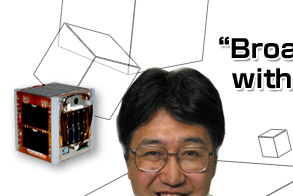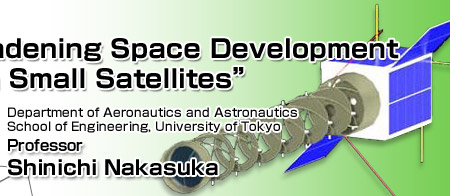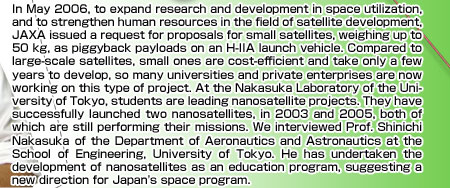
Q. What kind of research is now being conducted at your laboratory?
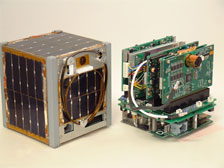
The first XI-IV nanosatellite, launched in 2003(Courtesy of Intelligent Space Systems Laboratory)
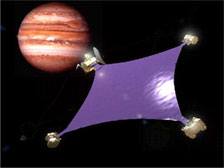
Furoshiki satellite(Courtesy of Intelligent Space Systems Laboratory) |
Our research has two primary pillars. One is future space systems. We are working on research and development for both very small and large space structures that are different from conventional satellites and space systems. For example, we're constructing nanosatellites that are incredibly tiny compared to the satellites we are used to seeing. The difference between a small satellite and a nanosatellite is in the weight. A small satellite weighs up to 500 kg, though most are in the 50 kg-class. Nanosatellites, on the other hand, are 10 kg or less, and a really light one can weigh as little as 1 kg. Nanosatellites are a totally new space system, so we are constantly thinking about potential uses, potential technical problems, and how to solve them.
As far as large-scale structures go, we have the Furoshiki satellite project for deploying a large membrane in space. The concept is that nanosatellites attached to each corner of a folded membrane will deploy it in space. We expect this system will have various applications. It could be used with very large solar-power satellites, as part of vast communication antennas, as radiator panels for satellites that generate a lot of heat, and for retrieving space debris, to name a few ideas.
Our other primary research pillar is artificial intelligence for space systems. We are studying autonomous intelligence and information-processing technology to make satellites and robots more sophisticated. For example, we would like to develop satellites that can evaluate their circumstances and adapt during flight. This is called learning, and in developing and implementing this function, we are hoping to advance the intelligence of satellites to the point that they can find solutions on their own, even in case of events that are beyond our imagination. This approach has already been introduced with some spacecraft, such as the Mars Explorer Rover, but we'd like to further improve the system, so that a satellite could "think," setting its own tasks, and even repairing itself, without receiving commands from ground control.
Q. What are the major achievements of your nanosatellite projects so far?
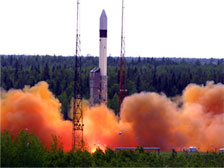
Launch of the nanosatellite XI-IV, at the Plesetsk Cosmodrome in Russia, June, 2003(Courtesy of Intelligent Space Systems Laboratory)

Image captured by XI(Courtesy of Intelligent Space Systems Laboratory)
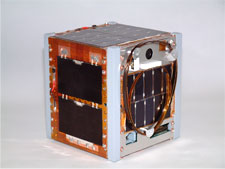
The second XI-V nanosatellite, launched in 2005(Courtesy of Intelligent Space Systems Laboratory) |
We constructed satellites called CubeSat XI, which were 10 centimeter-cubic and weighed just 1 kg, and succeeded in launching two of them, one in 2003 and the other in 2005. They were so small that we carried each of them to Russia, where we launched them, in a suitcase. Our objective was to demonstrate their basic technology - to test whether they would really work in space - but we also experimented with sending images taken by their on-board camera to Earth. The first of these satellites, launched in 2003, is still working. We would have been happy if it lasted for two months, but to our great surprise it's been working for more than three years. We had a tight budget, so we bought parts in Akihabara, which is often called the electronics capital of Japan. So we have proven that commercial components can be sufficient as long as they are well designed and manufactured. I think this was a remarkable achievement.
The on-board camera, which is the size of the ones used in cellular phones, captures an image every four or five days and transmits it to us on the ground. The camera has been doing this for three years, so we have obtained several hundred images. We are distributing the images with an attached message to people who have registered their e-mail address or cell phone, so that the public can become more familiar with space. This idea was suggested by students and has been very successful. There are currently about 2,000 people signed up, and we sometimes receive messages of encouragement in return. I think this is another example of our achievements. (XI MAIL STATION)
The next nanosatellite launch was in 2005. Its size and hardware were almost the same as the first one, but we greatly revised the software, as we had found a lot of deficiencies with the first one during flight operation. We improved the resolution of the on-board camera, too. A feasibility test for JAXA's new solar cells is also being conducted to test their durability in orbit. We're getting very good results so far.
While JAXA and space manufacturers are continually developing new technologies, it is essential for these technologies to be tested in space. The reality is, though, that a large satellite is launched only after years of development. Our nanosatellites, on the other hand, allow us to do feasibility tests as frequently as every year or two. The fruits of development do have an expiry date - the longer a test is delayed, the more its significance is diminished. New technology should be tested as soon as possible, and the results published globally. Our satellites are great tools for this objective.
|
